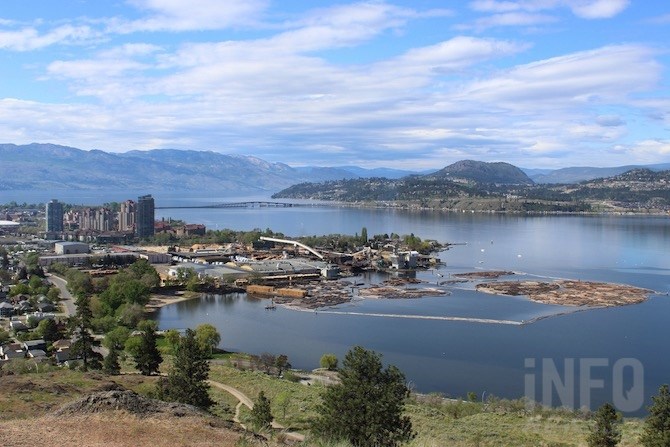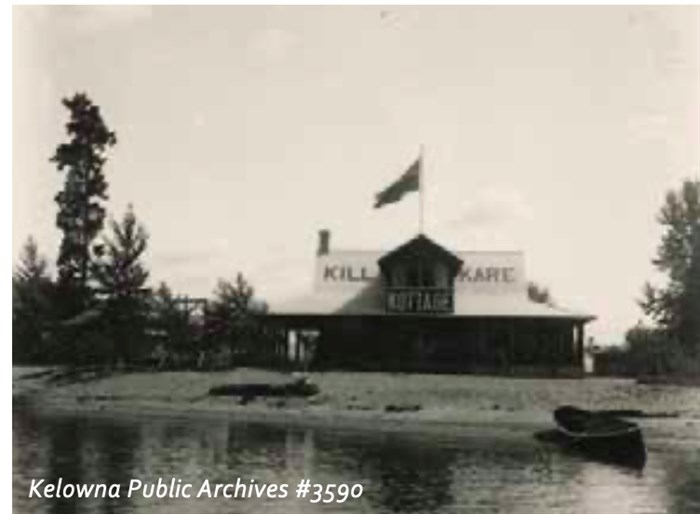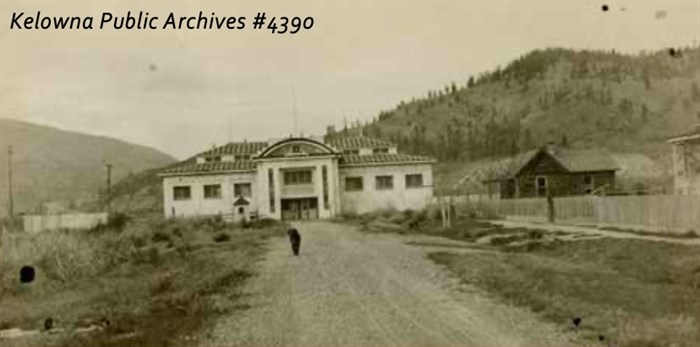
The closing of the Tolko Mill in Kelowna has led the city to look anew at the whole North End.
(ROB MUNRO / iNFOnews.ca)
November 15, 2021 - 7:00 AM
A planning exercise for the north end of downtown Kelowna comes with some historical tidbits most people may know nothing about.
The study covers the area from Clement Avenue to Knox Mountain and includes the closed Tolko Industries property on Okanagan Lake that is a prime site for redevelopment.
The first phase – a background study – goes to Kelowna city council on Monday, Nov. 15.
Naturally, long before there was a mill, an industrial section and war-time housing, it was land used by the syilx/Okanagan people.
But the report going to council starts with the early European settlers who farmed and ranched the land.
READ MORE: Kelowna in focus: The North End's humble roots and high end living
In the early part of the 20th Century, summer cottages appeared on Manhattan Point.

The summer cottage known as Killkare Kottage was built for Frank DeHart’s family in 1910.
Image Credit: SUBMITTED/City of Kelowna, Kelowna - Kelowna Public Archives
Around that time, the fields were used for things like polo, rugby, horse racing, rodeos and ice skating. In 1909, the Exhibition Grounds were created on what is now Recreation Avenue.

Kelowna's Exhibition Hall was built in 1913 and burned down in 1957.
Image Credit: SUBMITTED/City of Kelowna, Kelowna - Kelowna Public Archives
It included Kelowna Exhibition Hall that opened in 1913 and was destroyed by fire in 1957. There was a horse racetrack and, later, the badminton hall, baseball diamond and curling rink were built.
In 1905, Kelowna Brick Works was built where Knox Mountain Metals now operates. Brick from the plant can still be seen today in buildings like the First United Church at Richter Street and Bernard Avenue, which was built in 1909, a school at Richter Street and DeHart Avenue, built in 1913, the BNA Tobacco Company Factory on Ellis Street (1912) and the Laurel Packing House (1917). The Brick Works closed in the late 1930s.

The Laurel Packinghouse was built with locally manufactured bricks.
Image Credit: SUBMITTED/laurelpackinghouse.ca
The arrival of the CN Rail lines in 1925 shifted industrial development to the north of the downtown waterfront and by 1930, there were 22 packing houses, four canneries and other industrial operations along the rail line.
What ended up as the Tolko mill started as a box making plant owned by S.M. Simpson in the 1932.
READ MORE: Changing times: Tolko closure marks the end of a way of life, says local historian
Most of the “wartime” housing was built from 1945 to 1950 by returning veterans from the Second World War.
Gordon Elementary school was built in the 1950s then bought by the city in 2005 for future park use. It’s now occupied by the Justice Institute of B.C.
The rail line was shut down in 1997 and is now the Okanagan Rail Trail.
The north end is changing dramatically with housing, industrial and commercial developments along Clement Avenue and a burgeoning brewery district.
The closing of the Tolko mill in 2020 prompted the city to draft a plan for the entire neighbourhood in conjunction with an area structure plan for the Tolko site.
READ MORE: Kelowna moving quickly to plan redevelopment of Tolko mill site on Okanagan Lake
The neighbourhood plan now moves into Phase Two that includes creating a Community Liaison committee.
To contact a reporter for this story, email Rob Munro or call 250-808-0143 or email the editor. You can also submit photos, videos or news tips to the newsroom and be entered to win a monthly prize draw.
We welcome your comments and opinions on our stories but play nice. We won't censor or delete comments unless they contain off-topic statements or links, unnecessary vulgarity, false facts, spam or obviously fake profiles. If you have any concerns about what you see in comments, email the editor in the link above.
News from © iNFOnews, 2021